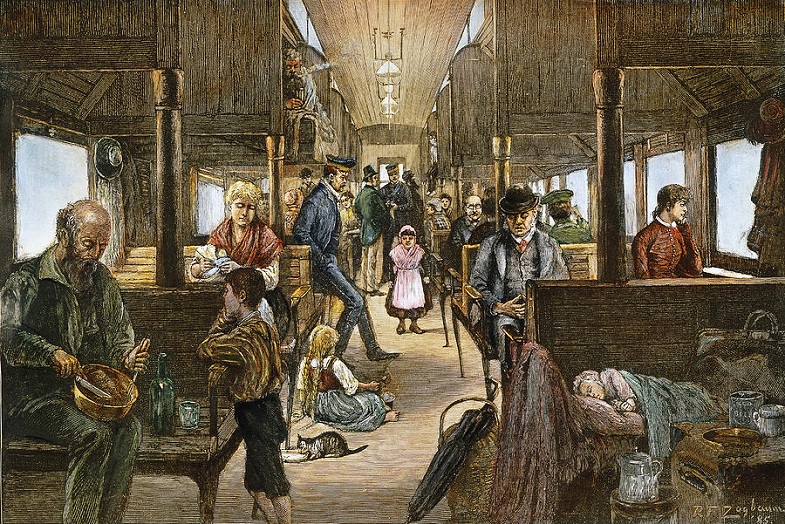|
The
|
THE BURGENLAND BUNCH NEWS - No. 280 September 30, 2017, © 2017 by The Burgenland Bunch All rights reserved. Permission to copy excerpts granted if credit is provided. Editor: Thomas Steichen (email: tj.steichen@comcast.net) BB Newsletter Archives: BB Newsletter BB Facebook page: TheBurgenlandBunchOFFICIAL BB Home page: the-burgenland-bunch.org Our 21st Year. The Burgenland Bunch Newsletter is issued monthly online. It was founded by Gerald Berghold (who retired from the BB in the Summer of 2008 and died in August 2008). |
| Current Status Of The BB: * Members: 2549 * Surname Entries: 8159 * Query Board Entries: 5688 * Staff Members: 12 |
NOTICE: Your Editor will be traveling in late October and early November, therefore, there will not be a BB newsletter published at the end of October. |
|
1) THE PRESIDENT'S CORNER (by Tom Steichen)  This
month's collection of bits and pieces ranges from an 800th-year anniversary, to 200-year-old
records, to modern times. Once you work your way back to the present, you can read some real
articles... This
month's collection of bits and pieces ranges from an 800th-year anniversary, to 200-year-old
records, to modern times. Once you work your way back to the present, you can read some real
articles...Article 2 has a whimsical title for a genuinely difficult "brick wall" that Brenda Csencsits faced in trying to discover the Roots of the Cherry Tree, that is, the family genealogy of her sister-in-law's Cherry family. In Article 3, we learn of the effort involved in the Establishment of the Apostolic Administration Burgenland, which was the Catholic church structure present in Burgenland between 1921 and 1960. Josef Rittsteuer, priest and Catholic Church Historian of Burgenland tells the story. Article 4 was prompted by a paragraph in an article written ten years ago by Margaret Kaiser. The paragraph provoked my interest and caused a new article to be written by me about Ellis Island and the Central Railroad Terminal of New Jersey. The remaining articles are our standard sections: Historical Newsletter Articles, and the Ethnic Events and Emigrant Obituaries sections. 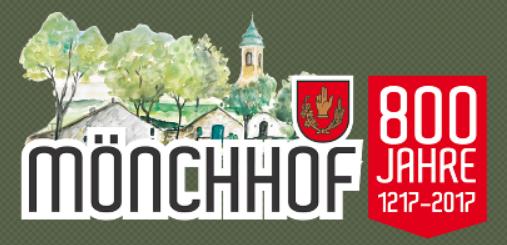 Mönchhof
800-year Anniversary Celebration Mönchhof
800-year Anniversary CelebrationRobert Thullner, of Herreid, SD, wrote to say: We just returned from a two-week visit to Austria. The Thullner family was honored, as second- and third-generation guests of paternal heritage, by the Mönchhof village that celebrated its summer-long 800th Jubilee, August 25, 26 and 27th. The village history book is fantastic but in German. I am sure extra copies are available from the Burgermeister's (Mayor's) Office in Mönchhof. A correspondence e-mail for the village office is post@moenchhof.bgld.gv.at. The 800-year commemorative Mönchhof history book is, presumably, an update of the book produced in 1967 for the 750th anniversary (listed in our Village Chroniks section here). The concluding three-day celebration started off on Friday afternoon with a special program for Mönchhof "emigrants," as Robert noted, including a meet-and-greet by the mayor and vice-mayor, a "hotter-ride" along the borders of the Mönchhof hotter (the area under Mönchhof control), and a visit to the Mönchhof Emigrant Museum led by an English-speaking guide and a "small drink" there. The main program (for all Mönchhofers, near and far) kicked off in late afternoon with the "Official Welcome and Opening of the Festival" by the Mayor and Vice-Mayor, followed by dancing and entertainment until midnight. Saturday's early events revolved around food and drink, with a grilling show and finger food tasting led by double-grille champion, Adi Matzek, followed by the presentation and tasting of the special "jubilee wines" by the vineyard association Mönchhof, and then demonstration and tasting of Mönchhofer "wedding bakery," "Wine cream," "Graded noodles," and "Mönchhofer Sterz." Late afternoon and early evening had more dancing and entertainment. Seven to nine pm was reserved for a Heimatabend with folk music, dialectical poems and "funny Mönchhof events," after which Mönchhof village musicians led more dancing and entertainment. Sunday morning started with the arrival and greetings of the special guests in front of the Pfarrkirche Mönchhof, a festival mass (broadcast live by ORF), and then a procession to the Angergasse horse pond park, where ceremonies were held. The formal ceremonies began with the "Festfanfare," a special music piece composed by Robert Ringwald for the 800th Anniversary, the welcoming of guests by Mayor Josef Kolby and greetings from State Parliament President, Rudolf Strommer, and Deputy Head of State, Johann Tschürtz. The "ceremonial address" was then presented by Governor Hans Niessl. Next was the presentation of the "Jubilee Song" for the 800th anniversary, composed by Michael Hoffmann and Andreas Salzer, and the presentation of the new Ortschronik by Dr. Sepp Gmasz, followed by the Burgenland national anthem. An afternoon social program followed, including "Club" displays along the Angergasse and more dancing and entertainment until 10 pm.  Lutheran
Birth Records for Parish Kukmirn: BB Member Patrick Kovacs has contributed transcribed
birth records from the Lutheran parish of Kukmirn. The database consists of all 8,733 birth
records from 1828 to 1895, being mostly for villages Güssing (Németújvar), Kaltenbrunn
(Némethidegkut), Kukmirn (Kukmer), Limbach (Harspatak), Neustift (Ujtelep), Neusiedl (Ujlak),
Olbendorf (Óbér), Tobaj (Tobaj), and Zahling (Kis-Körtvéles). The records can be accessed from
our Vital Records Transcriptions page in
sortable HTML and Excel formats. Patrick is currently transcribing the marriage records for the
parish, which we hope to add when that database is complete. Lutheran
Birth Records for Parish Kukmirn: BB Member Patrick Kovacs has contributed transcribed
birth records from the Lutheran parish of Kukmirn. The database consists of all 8,733 birth
records from 1828 to 1895, being mostly for villages Güssing (Németújvar), Kaltenbrunn
(Némethidegkut), Kukmirn (Kukmer), Limbach (Harspatak), Neustift (Ujtelep), Neusiedl (Ujlak),
Olbendorf (Óbér), Tobaj (Tobaj), and Zahling (Kis-Körtvéles). The records can be accessed from
our Vital Records Transcriptions page in
sortable HTML and Excel formats. Patrick is currently transcribing the marriage records for the
parish, which we hope to add when that database is complete.Our thanks to Patrick for sharing his work with the BB membership. We also invite you, dear readers, to share any Burgenland transcriptions you have done. Digital Edition for the Younger Jewish Cemetery of Eisenstadt: Genealogist Traude Triebel reports that the Austrian Jewish Museum (Österreichischen Jüdischen Museum) has completed the initial version of an online database, found here: ojm.at/blog/friedhof-eisenstadt-jung/archiv/, of Hebrew gravestones in the Younger Jewish Cemetery of Eisenstadt. A write-up (in German) about the project is here: ojm.at/blog/friedhof-eisenstadt-jung/. 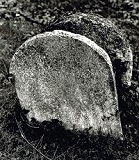 This
is the third digital edition, joining those for the Older Jewish Cemetery of Eisenstadt
and the Jewish Cemetery of Mattersdorf/Mattersburg. Johannes Reiss, director of the
Museum, has been working on this digital edition since the beginning of 2017. Now all 258 of the
Hebrew headstone inscriptions are transcribed and online, and encompass deaths in the 1842-1987
period, although only two are for deaths before 1872 and only 2 for deaths after 1945. This
is the third digital edition, joining those for the Older Jewish Cemetery of Eisenstadt
and the Jewish Cemetery of Mattersdorf/Mattersburg. Johannes Reiss, director of the
Museum, has been working on this digital edition since the beginning of 2017. Now all 258 of the
Hebrew headstone inscriptions are transcribed and online, and encompass deaths in the 1842-1987
period, although only two are for deaths before 1872 and only 2 for deaths after 1945.The Austrian Jewish Museum has a goal to work up all 14 Jewish cemeteries in Burgenland, with about 8,000 tombstones, and translate the Hebrew inscriptions. The digital editions are an online revision, enhancement and extension of Johannes Reiss' 1995 book, "Hier in der heiligen juedischen Gemeinde. Die Grabinschriften des juengeren juedischen Friedhofs von Eisenstadt." Waschtisch - Washing Table: Christine Rubba, born in Steinberg, Burgenland, and living since 1968 in Alberta, Canada, wrote to say: 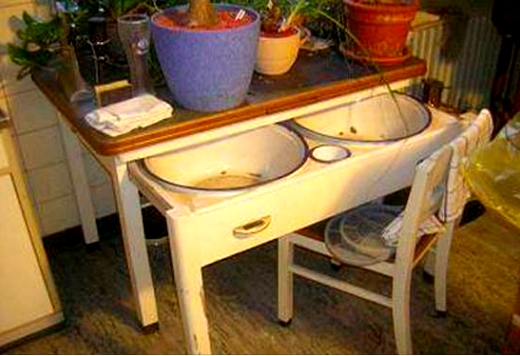 Hi
Tom, I saw an interesting item on Facebook and thought you might like to use it in the
Burgenland Bunch Newsletter. My grandmother used to have one like that. I tried to post it on
the Burgenland Bunch Facebook page and, since I don't know whether you look at that Facebook
page, I thought I will share it with you. Hi
Tom, I saw an interesting item on Facebook and thought you might like to use it in the
Burgenland Bunch Newsletter. My grandmother used to have one like that. I tried to post it on
the Burgenland Bunch Facebook page and, since I don't know whether you look at that Facebook
page, I thought I will share it with you.I found this interesting, of course, as it likely was a common but ingenious type of space-saving furnishing in the pre-indoor-plumbing Burgenland of our ancestors. To be honest, it is the first of its kind I have seen, though in searching the web, I can find other examples of it. I'm much more aware of the porcelain wash basin bowl and pitcher sets seen in Victorian bed-and-breakfasts. If you have other interesting items of immigrant-era life, please do share with me so I can share with the membership.  New
Editor for Burgenland Recipes: Starting this month, BB Links Editor, Alan
Varga, will be taking on an additional role of BB Recipes Editor,
primarily responsible for obtaining and preparing a monthly recipe to be inserted in the BB
Newsletter but also the development and maintenance of a "recipe index" file pointing to the
many recipes and food-related articles that have been published in past newsletters as well as
authoring occasional articles for the newsletter about food and recipe preparation. Alan has an
interest in expanding his love of cooking and eating Burgenland ethnic food, so this is a great
fit for him. In addition, he tells me that his daughters want to explore the old recipes, so he
has multiple "test kitchens" in which to try out recipes. New
Editor for Burgenland Recipes: Starting this month, BB Links Editor, Alan
Varga, will be taking on an additional role of BB Recipes Editor,
primarily responsible for obtaining and preparing a monthly recipe to be inserted in the BB
Newsletter but also the development and maintenance of a "recipe index" file pointing to the
many recipes and food-related articles that have been published in past newsletters as well as
authoring occasional articles for the newsletter about food and recipe preparation. Alan has an
interest in expanding his love of cooking and eating Burgenland ethnic food, so this is a great
fit for him. In addition, he tells me that his daughters want to explore the old recipes, so he
has multiple "test kitchens" in which to try out recipes.Given this, we would like to introduce the new recipe index page, found here: Burgenland Bunch Recipes and a new email address for sending in recipes and other food-related comments, be they about recipes, restaurants or your own explorations into ethnic foods: recipes@the-burgenland-bunch.org. Please welcome Alan into this role by inundating him with contributed recipes! Poropat DNA Surname Project: I recently received a message from Luka Poropat, administrator of the Poropat Surname Project at FamilyTreeDNA. 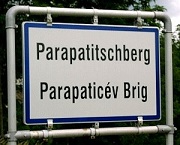 His
project may be of interest to some BB members, as the Burgenland surname Parapatits/Parapatics
(and other variations) likely derives from the same Romanian surname, Farapat, as the
more recent Croatian surname Poropat; further, a Georg Parapatic from Kohfidisch is
believed to have founded Parapatitschberg in the 1600s, which is near Weiden bei Rechnitz
in Burgenland. The surname remains in present-day Burgenland (and elsewhere in Austria and
Hungary) His
project may be of interest to some BB members, as the Burgenland surname Parapatits/Parapatics
(and other variations) likely derives from the same Romanian surname, Farapat, as the
more recent Croatian surname Poropat; further, a Georg Parapatic from Kohfidisch is
believed to have founded Parapatitschberg in the 1600s, which is near Weiden bei Rechnitz
in Burgenland. The surname remains in present-day Burgenland (and elsewhere in Austria and
Hungary)Luka asked if we could "help the Poropat Surname Project by informing, especially male, people with these surnames in Hungary or Austria to do a Y-DNA test and join the Poropat Surname Project?" The answer is, of course, yes; thus this message. More information about
the Poropat Surname Project can be found here:
familytreedna.com/groups/poropat-surname/about/background. The Burgenland Integrationszentrum consists of an office and a training room, where
the eight-hour-long courses are taught. Refugees begin by signing an "integration declaration"
during an orientation consultation, wherein they declare to respect the fundamental values and
the legal and social order of Austria, as well as to comply with the statutory obligation to
participate in and finish the offered courses. |
2) ROOTS OF THE CHERRY TREE Editor: I've written before that one of the keys to successfully breaking through a genealogical "brick wall" is to use all the information you have, even if some of it doesn't seem useful at first. The following member-assistance article documents one more brick wall crashing to the ground, with the past shining through the gap...  BB
Member Brenda Csencsits wrote, saying (in part): I am a member of the Burgenland
Bunch and am currently researching the lineage of my brother’s (Csencsits) wife’s father
(Robert Cherry). By researching US Federal Census records (1910-1940), I
found Robert Cherry’s father, Joseph Cherry, and Joseph Cherry’s father, Frank. Frank’s WW II
Draft Registration Card shows he was born January 9, 1886 in Gissing, Hungary. I
assume this is what is now Güssing, Austria. The 1910 census shows his surname spelled as “Jeri”
and that he immigrated to the USA in 1906. The 1920 census shows his surname as “Jerry.”
I have not been successful at locating him on a passenger list. I looked on
familysearch.org at Hungarian church records and
cannot find his baptism record. I’ve done various Google searches to try to find a clue
but came up with nothing. BB
Member Brenda Csencsits wrote, saying (in part): I am a member of the Burgenland
Bunch and am currently researching the lineage of my brother’s (Csencsits) wife’s father
(Robert Cherry). By researching US Federal Census records (1910-1940), I
found Robert Cherry’s father, Joseph Cherry, and Joseph Cherry’s father, Frank. Frank’s WW II
Draft Registration Card shows he was born January 9, 1886 in Gissing, Hungary. I
assume this is what is now Güssing, Austria. The 1910 census shows his surname spelled as “Jeri”
and that he immigrated to the USA in 1906. The 1920 census shows his surname as “Jerry.”
I have not been successful at locating him on a passenger list. I looked on
familysearch.org at Hungarian church records and
cannot find his baptism record. I’ve done various Google searches to try to find a clue
but came up with nothing.I’m pretty sure my difficulty lies in what is now the surname “Cherry” being something else in the region he came from. If you have any tips on what to do next, I’d be most appreciative. Unfortunately, Robert Cherry can’t shed any light on the “Cherry” name. I replied, saying: Hi Brenda, Gissing might be a misspelling of Güssing... but it more likely is the properly-spelled German name for the town known as Sopronkövesd, Hungary; it borders on Burgenland and can be seen here: googlemaps/Sopronkövesd. [Editor: As you will see below, being "more likely" did not make it true!] Most certainly your problem in tracking him has to do with the “Cherry” name ...as you expect, it almost certainly wasn’t spelled that way over there. Do you know his religion? Roman Catholic records for Sopronkövesd are available in image format here: familysearch.org/search/catalog/121976. Lutheran records are in another town, but I’d have to dig a bit to find out where. Brenda replied (in part): Hi Tom, I checked the films you referenced and did find a Ferencz born on the date I have for Frank Cherry's birth (January 9, 1886). However, this Ferencz's parents' last name [Editor: Bognár] doesn't resemble anything that could be Cherry. I've attached the record I found. 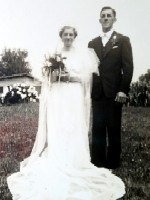 On
another track, Frank Cherry's wife was Anna Schaffer, born to Frank Schaffer and Maria
Oswald. Based on information from census records, I'm pretty sure the attached NY Passenger
List record (line 21) is the Anna Schaffer I'm interested in [manifest not included in
this article]. The year of birth, year of immigration, father's name and father's residence
all match. I was wondering if you could tell me anything about the residence listed for Anna
from Hungary. It looks like "Egyhazaro" to me. Google translate tells me Egyház
means church. Any ideas? On
another track, Frank Cherry's wife was Anna Schaffer, born to Frank Schaffer and Maria
Oswald. Based on information from census records, I'm pretty sure the attached NY Passenger
List record (line 21) is the Anna Schaffer I'm interested in [manifest not included in
this article]. The year of birth, year of immigration, father's name and father's residence
all match. I was wondering if you could tell me anything about the residence listed for Anna
from Hungary. It looks like "Egyhazaro" to me. Google translate tells me Egyház
means church. Any ideas?Thanks in advance for any light you can shed on this. I really appreciate you and the work you and the BB do. I replied: Hi Brenda, that Ferencz Bognár is a question, however, the note at the end of the record says he married Sept. 20, 1911 in Sopronkövesd with Teréz Kis. I’d presume your guy was in the US then. As for Anna’s record, I read it as Egyházas ...unfortunately, there are at least 18 Hungarian villages that have that as the first part of its name (and none with it as its complete name, so it must be shorthand for the full name). One of them is Egyházasfalu, which is about 7 miles straight south of Gissing. But another is Egyházasfüzes (Kirchfidisch) which is about 7 miles north of Güssing. And Egyházasrádóc, Egyházasszecsöd and Egyházashollós are about 15 miles east of Güssing and 35 miles south of Gissing, while Egyházashetye and Egyházaskeszo are further from Güssing but closer to Gissing than the previous three. The rest are more distant. The name most certainly has some meaning related to church or ecclesiastical. I’d guess the church once owned the various villages, giving them the first part of their names. One other thought... Egyházas is listed as her last place of residence, not her place of birth (though it might be). Brenda replied: Thank you very much, Tom. Genealogy research can be so difficult! But, then again, what was I expecting - hahaha.  Editor: And that then seemed to wrap up this question, as we had pulled all the threads Brenda had and her brick wall was still standing firm... but had we actually pulled all the threads? In fact, Brenda had dangled another thread when she mentioned that Frank Cherry's wife was Anna Schaffer. From the 1910 census, we knew that Frank and Anna married in 1909 or 1910, as they were listed as being married for one year, that they had a 6-month-old son born in Pennsylvania, were 24 and 22 years of age, respectively, and that they were living in Coplay, PA. The census record also indicated that Frank had emigrated in 1906 and Anna in 1904 (matching the passenger list Brenda had shared with me, which said Anna was 17, single and going to Northampton). All of this strongly suggested that the marriage of Frank and Anna likely occurred in 1909 in the Coplay area... so we had a thread we could pull, but we would need to do so with Anna's name. Now "Schaffer" is not an easy name to research, as it is so common, but we could reduce the number of "Anna Schaffers" we found by using other limiting data, such as ages, places of birth, etc. Going to familysearch.org and putting in Anna's first and last names, spouse first name Frank, and Pennsylvania and 1909 for place and year of marriage, yielded the following as the first result returned (partial image used for display here): 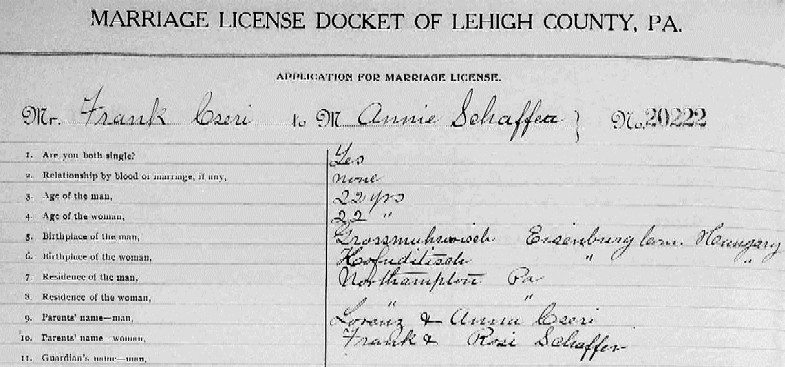 This prompted further research from me and a series of email messages to Brenda (which I'll compact into one): I wrote: Brenda, See the attached image (above). If correct, it calls into question what you believe about Anna’s mother. By the way, Grossmürbisch is in the Güssing district, not far from Güssing. Kohfidisch is the sister town to Egyházasfüzes (Kirchfidisch) and Kirschfidisch is where the Catholic records are. See also the top record on this page (birth date 21 Mar 1888):  Two more attachments to look at... The first is an illegitimate birth of a Franciscus on Jan 18, 1887 in Nagymedves (Grossmürbisch).  The second is the marriage of the mother on Feb 5, 1888 in Szent Miklos (St. Nikolaus), parish for Grossmürbisch.  Brenda replied (again, in a series of messages that I'll compact into one): [Concerning the Cseri / Schaffer marriage] How did you find this marriage record for Frank and Anna? I've been searching and searching. By the way, in a previous email to you I said Anna's mother's name was Maria. I meant to say Rosina. [Editor: I was relieved to hear this!] It was late and I may have been thinking of Marie Osmond, the singer (my mind works in mysterious ways - hahahaha!). THANK YOU SO MUCH. This record fits perfectly with other data I have. Their first son was born around 1910 based on census data. [Concerning the Anna Schaffer birth] This record is also a good match because I have Anna's birth date as 20 Mar 1888. [Concerning the Franciscus Forjan birth, 18 Jan 1887] I'm not sure what to make of this. I've attached the WW-I and WW-II draft registration cards for Frank Cherry, both noting his birth date as Jan 9, 1886. (Thomas was his second-born child. [Ed: The WW-I card gives Mrs. Annie Chery as nearest relative; the WW-II card gives Joseph Cherry... I think Brenda meant to say Joseph, not Thomas]) But as we know, dates can be off on some of the records. The information you have given me follows a very logical path. I'm going to take a little more time to study this tomorrow. How concerned are you about the dates being 9 days off? Again, thank you, thank you, thank you!!! I replied: Marriage record: Rev. John A Seimetz was pastor of St. Mary’s Catholic church (now Annunciation) in Catasauqua [Ed: he was the guy who signed the marriage record, and Catasauqua is less than a mile from Coplay]. I found it [the marriage record] by using lots of wildcards in my search and depending more on her name. Anna’s birth record: oops, the birth date was the 20th; 21 was baptism date. Frank’s birth record: it is a year and 9 days off! Given he said he was 22 on the marriage record, that would put his birth year as 1887 ...so if he got the year wrong 8 and 33 years later (on his draft registrations), why not the date too? The general advice is to use the age report that occurred nearest to the event—it is the least likely to be wrong. I’ve worked through records from all around the Güssing area, and this birth is the only one that worked out as a Cseri birth with the reported parents (Cseri is a rare name!). So this is a “proof” by lack of any other reasonable answer. All in all, it seems a reasonable package, despite the inconsistencies. It is a bit much, I know, which is why you are correct to think on it. By the way, if you decide to accept this as correct, his father was then born in Steingraben (Banya) and I found that record too (his parents are listed on his marriage record). I’m sure Anna Forjan’s birth could be found too [Ed: I found it later; and also the death record for the father]. Oh, and here is his Ellis Island record: libertyellisfoundation.org/CseriFranz 27 Aug 1906, age 20, going to Allentown from 'Ronok' (Rönök, just south of Grossmürbisch), joining friend Aloysia Miller. [Ed: Interestingly, in the 1910 census, Frank and Anna are hosting boarder Frank Miller, presumably related to Aloysia.] Brenda replied: Again, Tom, I can't thank you enough. I had discovered the same record for Frank Cherry's immigration and your discovery assures me it's the right one. On the marriage record for Laurentius and Anna, I see "Banya" then something I can't read, then Nagymedves. Do you know what the word is in between Banya and Nagymedves? [I replied: It is the Hungarian name for Güssing: Nemetújvar. Banya is the Hungarian name for Steingraben, so the whole thing means the Banya near Nemetújvar.] I'll need to take some time to find the birth records of Lorenz Cseri and Anna Forjan [Editor: these were found]. My mind is growing weary at this point. Time for me to start organizing what I have! You are a wonderful resource and so knowledgeable in all things Burgenland. I would never have been able to interpret the writing, let alone translate Hungarian town name to present day town names. I so much appreciate you! 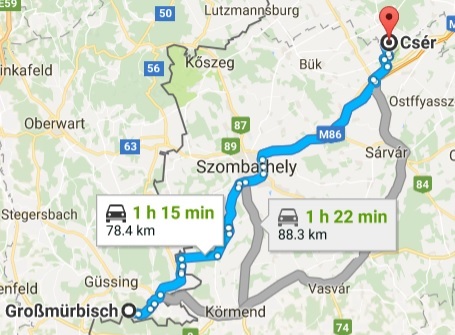 I
replied: I did a little further looking and found out that Cseri means ‘being
from the town of Cser’, which is here: I
replied: I did a little further looking and found out that Cseri means ‘being
from the town of Cser’, which is here:Also, cs in Hungarian is pronounced ch, as in cherry! (Though the online pronunciations I found usually soften the name to sound more like sear-ry). Thus the use of Cherry in the US seems quite reasonable! Later, I found this on the web: Pronunciation of Cseri: It is pronounced "Cherry", just like the fruit. It is a Hungarian name, where the "cs" is pronounced like the English "ch". Type of Name: Last Name Origin: Hungarian [For which, Brenda commented: "I kind of knew that 'CS' is pronounced 'CH' from my Catholic school days when the Hungarian nuns called my sister, brother and me the 'Chenchits' kids :-)"] Editor: Brenda and I exchanged further messages about other aspects of her research, but I'll not include them here. I will, however, mention one final piece to the Cherry / Cseri exchange: Brenda wrote: I was wondering how anyone would know if Lorenz Cseri is Frank's biological father since Frank was born illegitimately. I suppose if there were DNA samples from Bob Cherry (grandson of Anna Forjan) and one of Anna's other grandchildren fathered by Lorenz it could help. Just something else for me to think about. I replied: DNA might help... but it (autosomal DNA) might just see the deep inter-relationships of the peoples from Burgenland instead. Further, the fact that the putative paternal cousins would have a known connection via Anna (they will be cousins through her) will make it more difficult to see a separate connection via Lorenz (but it might be possible). However, a hit on the Y-chromosome would be absolutely definitive, but it isn’t included in an autosomal test, so Y-DNA tests would be needed (then Anna would not be involved). Later, I did a follow-up reply, saying: I had a second thought, Brenda, on your question wondering “how anyone would know if Lorenz Cseri is Frank's biological father.” A possible answer might be in the original parish records. I underline “original” because we are looking online at the copy that went to the Hungarian authorities. The parish kept the original and annotated it, even years later, as appropriate... but those annotations are not in the copy, as the copy of the just-past year was sent in yearly. It was not unusual for the original record to note that a child was “legitimized” by the later marriage of his biological parents. If you or someone could review that page in the original records, you might have your answer. Editor: So, although we have not definitively proven that Frank Cherry and Franciscus (Forjan) Cseri are the same person, the evidence for that contention seems stronger than the evidence against it. Brenda still has a couple of avenues (DNA and original records) that might prove our contention beyond all reasonable doubt. However, it was pulling the thread dangling from his wife's name that put us in position to have that opportunity. Clearly, Brenda was aware that the Cseri name was phonetically similar to Cherry (although I was not) and had at least considered some of the Cseri records as possibilities. Her difficulty was not being able to find a logical trail that allowed those records to make sense... I submit that we have now found that trail. |
3) ESTABLISHMENT OF THE APOSTOLIC ADMINISTRATION BURGENLAND (by Josef Rittsteuer) Translated from zobodat.at/pdf/Burgenlaendische-Heimatblaetter_23_0130-0137.pdf Burgenländische Heimatblätter 23, 1961, pp 130-137. Original endnotes are indicated as a number in parentheses, for example (1); my occasional inserted comments are in square brackets, []. In the text, the capitalized word Church refers to the Catholic Church. Ed. note: An Apostolic Administration is a territory that is not a Diocese and is led by an appointed prelate called an Apostolic Administrator. The Apostolic Administration Burgenland was elevated to a Diocese in 1960. Author Josef Rittsteuer (1914-2015) was a Catholic priest who was actively involved in the establishment of the Diocese of Eisenstadt. Later, because of his historical research, he became known as the Church Historian of Burgenland. Josef Rittsteuer writes: The First World War destroyed the Austro-Hungarian monarchy and dissolved that great Central European economic body, which had played a great role for centuries, into a series of national structures. Probably the most painfully affected by this development were the Magyars. For Hungary lost almost two-thirds of its population and more than two-thirds of its former territory through the peace negotiations. The slogan of the Magyars, who were threatened in their existence after the war, Nem, nem, soha (No, no, never), is therefore quite understandable; but it was quite ineffectual if we ignored the restitution of Ödenburg to Hungary, which was already given to Austria. The Peace Treaty of St. Germain (1919) awarded a large part of German-West Hungary, with a population of about 341,000 souls, to German-Austria. This meant that the question had to be clarified as to what had to be done with the [Catholic] Church because, in the new Austrian state, which had been called Burgenland since 1919, it had belonged to the Hungarian dioceses of Györ (Raab) and Szombathely (Steinamanger). How did the Austrian government present the solution to these ecclesiastical questions? In the Diocesan Archive in Eisenstadt is a document written by the government in Vienna on October 8, 1919, almost exactly a month after the signing of the Peace Treaty of St. Germain. In this letter addressed to the Holy See in Rome, the Austrian government (1) asked for the sending of an Apostolic Delegate to Ödenburg. This request is justified by the fact that the population of Burgenland is quite divided in religious terms, because almost a third belong to Protestantism and the Jewish religious community. (2) It was, therefore, desirable, almost necessary, that as soon as possible an Apostolic Delegate be sent to Ödenburg, who with a strong hand could bring about a favorable settlement of all religious questions for the Catholic Church. The situation in Ödenburg, the future capital of the new Federal State, will be pointed out with particular emphasis. Here, of the 33,478 inhabitants, only about two thirds were Catholic (21,446), while 9,592 were Protestant and 2,440 were Jews. The situation is endangered by the fact that the Protestants have a "bishop" in this spiritual center, have a lyceum with an evangelical theological faculty, and have their own teacher-training institution. Thus the Protestants, if nothing happens from the Catholic side, could influence the cultural life of the city, and thus of the whole country very strongly. It is therefore essential that a man should be appointed as a Delegate, endowed with the authority of the Pope, able to defend and lead the Catholic cause with undaunted and effective influence. The government proposes to take this Papal representative from among the ranks of the German-Austrian clergy, which is above the national antagonism that still prevails in West Hungary. Apart from 245,000 Germans (3) there are still 46,000 Slovaks (correctly: Croats) and 41,000 Hungarians (4) living in Burgenland. The intelligentsia in the cities, especially the officials and the teachers in the lower and middle schools, are either Hungarian or Hungarian-speaking. On the other hand, there are almost only Germans in the country. With regard to the ministers active in pastoral care, none are informed about this note to the Holy See. They are, almost without exception, either real Hungarians or educated in the Hungarian national spirit and, therefore, Hungarian. So it is understandable that, not only in public life, where no German word may be used in court or in the various offices, but also in Catholic schools and in the Church, that Magyarism is becoming more and more popular. (5) Interestingly, in describing the national difficulties, the Croats are not mentioned at all. This actually corresponds to the conditions at that time. For as long as the Croats and their chaplains lived in the Hungarian State, they were hardly aware of their nationality. They felt themselves to be good Hungarian patriots and negotiated afterwards. It was only after the Anschluss with Austria that they began to emphasize their own Croatianity, a phenomenon which, however, was already in abeyance. From the contrast between the Hungarian attitude of the clergy and the German-Austrian attitude of the faithful, the Church further stressed that the Burgenland Church might face many difficulties in the future. It would therefore be unfavorable, said the Austrian Government, that the Hungarian bishops in Raab and Steinamanger will continue to lead Burgenland Catholics in the future, even if this were done by vicarsmen taken from the Burgenland clergy. It is imperative that an Apostolic Delegate be appointed, independent of the Hungarian bishops, that is, a priest from Austria who is directly appointed by Rome. Such a system could produce the necessary peace and the right understanding between the Church of the Burgenland and the Austrian State. In the end, a complete detachment of the new territory would have to be worked out by the former Dioceses Raab and Steinamanger, as already stated in an earlier note (6). The establishment of a new Diocese of Ödenburg was hardly associated with any great difficulties, the Austrian Government said, since a sufficient dowry of the new bishopric could be obtained from those goods that lie on Burgenland soil and belong to the Raaber bishop or the Cathedral Chapter (7). In addition, there is already a well-founded College Chapter in Ödenburg, which could be converted without further ado into a Cathedral Chapter. In the future Episcopal city, various religious conventions also have settlements (e.g., the Benedictines, (8) the Dominicans, the Ursulines, etc.), which is also beneficial for the Diocesan establishment. Finally, at the Thomas College in Vienna, where theologians from all over Austria are already studying, a separate priestly seminar for the Burgenland was to be set up (9), which would provide for the urgently needed creation of German priests. No one would be able to conduct and carry out all these necessary preparations and works better than an Apostolic Delegate in Ödenburg. Although this note was never sent to Rome (10, 11), its content had been made known to the Holy See, possibly by the then Chancellor, Dr. Renner, who was in Rome on April 4, 1920, for discussions with the Italian government and then also with the Holy Father. As the press has said, Pope Benedict XV was very much interested in the situation in Austria and donated the fair amount of 1 million lire (11) to remedy the most severe need. With regard to these plans of sending a Delegate to Ödenburg and establishing a diocese of their own, the Austrian Government found little sympathy with the Pope. The whole situation was much too unclear. And Rome is rarely thoughtless. The construction of a new diocese is never 'broken over the knees' [Ed: prematurely, without due consideration]. This is always well considered. So one waited until a final agreement between Austria and Hungary was made regarding Burgenland and the city of Sopron. Then one would act. On March 31, 1921, the administrative office for the Anschluss of the Burgenland to Austria requested the Federal Ministry of Education to intervene in Rome to find a solution to the ecclesiastical questions. Let us reestablish the borders of the Hungarian dioceses Raab and Steinamanger, which would make the Burgenland independent, or at least the sending of a Delegate to Ödenburg. However, neither could be achieved for the time being (12). In the same affair a few weeks later, a member of the administrative office, Meidlinger, personally addressed Cardinal Piffl and the papal nuncio in Vienna; but he too could not be given a binding promise. It was pointed out to him that, on this question, in which the Viennese circles of the Church were very well informed, a decision could be made only if the Viennese and the Budapest nuncio were in agreement. (13) In fact, the official establishment of the Apostolic Administration took place by a decree of the Viennese nuncio, Franziskus Marchetti Selvaggiani. 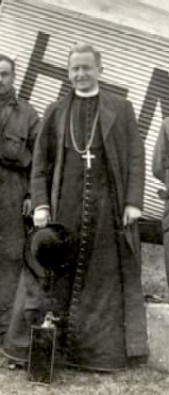 Unlike
the Austrian government, the Hungarian bishops of Raab (Anton Fetser) and of Steinamanger
(Johann Graf Mikes) presented their solution to the question of how Burgenland was to be
administered in the Church in the future: they simply wanted to leave everything as it was. They
did not, at first, make any calculations for a reorganization in the ecclesiastical sphere. The
peace treaties of St. Germain and Trianon were regarded only as temporary, which
soon had to give way to another favorable solution to Hungary. Therefore, nothing happened at
all, either in Raab, or in Steinamanger. The bishops regarded the Burgenland as a part of their
dioceses, made orders as they had ever before, used parishioners, appointed chaplains, etc. Unlike
the Austrian government, the Hungarian bishops of Raab (Anton Fetser) and of Steinamanger
(Johann Graf Mikes) presented their solution to the question of how Burgenland was to be
administered in the Church in the future: they simply wanted to leave everything as it was. They
did not, at first, make any calculations for a reorganization in the ecclesiastical sphere. The
peace treaties of St. Germain and Trianon were regarded only as temporary, which
soon had to give way to another favorable solution to Hungary. Therefore, nothing happened at
all, either in Raab, or in Steinamanger. The bishops regarded the Burgenland as a part of their
dioceses, made orders as they had ever before, used parishioners, appointed chaplains, etc.A change of this attitude of the bishops occurred only after the invasion of Burgenland by the Austrian gendarme (since 28 Aug 1921). The Hungarian liberation chancellors set themselves back to battle, and, after a certain tossing back and forth in Burgenland, set up their own, independent and neutral state, which they called Leitha-banat. Apparently Graf Mikes agreed with this development of things. But this led to certain difficulties in the free circulation between Hungary and the Leitha-banat because official Hungary did not recognize the new state. At that time, the head of Steinamanger appointed a new vicar-general (15) in the person of the Archpriest (Dechant) of St. Michael, Franz Thomas, (14) for that part of the new territory which had previously belonged to his diocese, and who succeeded in managing the territory independently in the name of the bishop. In addition, the Dechant Matthias Heiß of Lockenhaus was given certain dispensations for his Dean's Office because even traffic within the Burgenland encountered the greatest difficulties (16). The further political development has made this Episcopal order illusory. On the basis of the Venetian Protocol (October 13, 1921), Hungary undertook to evacuate Burgenland with the exception of Ödenburg and its immediate surroundings; there was to be a popular vote on whether that population would remain with Hungary or be annexed to Austria. A month later the Burgenland could be occupied by an Austrian military and the Leitha-banat ceased to exist (17). As relations between Austria and Hungary became normal again, Graf Mikes, after a discussion with his Vicar General and with a few Deans of the Burgenland part of the diocese, informed the Burgenland pastors in a letter dated 3 February 1922 that he had rescinded the office of Vicar General Thomas and again taken over administration of the whole diocese, as there was no longer any fear of hindered intercourse within his diocese. (18) At the same time precise instructions were issued to the Burgenland parishes. In future, input should be made to the Episcopal Ordinariat in the Latin language. However, it is also permitted to do so in the vernacular, namely Hungarian and German (19). On the other hand, the Ordinariat would send printed copies of German imprints to the Austrian parishes. The register book extracts were issued in German. However, the entries in the Church (20) register books had to be in Latin. The Episcopal Office will continue to be Hungarian (for financial reasons, as it was called), but the shepherds' letters would also be printed in German. For the Croatian believers, the pastoralists may translate the texts into Croatian and thus bring the readings to them. The parishioners would receive a Latin, instead of the previous Hungarian, text. The Church accounts had to be kept in the Hungarian currency and in the Hungarian language until further notice. With regard to the schools, it was decided that the official language was German, but that the rights of the Church to the Catholic schools should not be given up. It was also suggested to the priests to be in contact with the Austrian authorities in order to avoid unpleasant difficulties. In order to relieve the Episcopal Office, the Dechanten was given the authority to be able to grant marriage disputes. In contrast to Graf Mikes, the bishop of Raab, Anton Fetser, who had come from Großwardein only after the war, had become less active in Raab in the effort to prevent the Anschluss of Burgenland to Austria. He allowed the events, which were simply not to be prevented, free run. On the other hand, he was even more affected by the new frontier than his official brother in Steinamanger. For while he lost 40% of his parishes to Austria, the Bishop of Steinamanger lost only 30%. The approximately 100,000 Catholics of the Diocese of Steinamanger who came to Austria formed only about one-fifth of his total, while the Raaber bishop lost 38% of his faithful. Considering all this, one will also be able to more easily understand the attitude of Hungarian bishops to the issue of union. 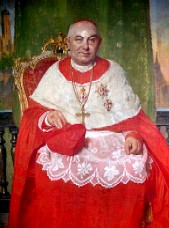 The
final decider on the question of the ecclesiastical administration of Burgenland was, of course,
the Holy See in Rome. On May 4, 1922, the two bishops, Fetser and Mikes, who were
affected by this decision, were informed by the new nuncio in Budapest, Lorenzo Schioppa,
that the Holy Father Pius XI (elected on 6 February, crowned on 12 February 1922) had
elected the Cardinal of Vienna, Piffl, the Apostolic Administrator of the territory of
West Hungary, which is commonly called Burgenland. (21) The
final decider on the question of the ecclesiastical administration of Burgenland was, of course,
the Holy See in Rome. On May 4, 1922, the two bishops, Fetser and Mikes, who were
affected by this decision, were informed by the new nuncio in Budapest, Lorenzo Schioppa,
that the Holy Father Pius XI (elected on 6 February, crowned on 12 February 1922) had
elected the Cardinal of Vienna, Piffl, the Apostolic Administrator of the territory of
West Hungary, which is commonly called Burgenland. (21)This news has been very hard on the two chiefs. Mikes explained (22) that the Holy See had neither brought the opinion of the bishops concerned nor the prince of Hungary into this important matter. This made him feel seriously offended. But above all "patriotic pain" he would submit to obedience, firmly convinced that "this new situation could only be a temporary state," and in a very short time "the torn coat of St. Martinus" would be reassembled. In a letter to the new Administrator, Friedrich Cardinal Piffl, Bishop Mikes was also "deeply offended" about this "temporary" solution. He then asked the Cardinal to sit with him and the Raaber Bishop concerning the appointment of the future Provikar [Deputy], with whom they would have so many questions to solve. (23) Still from Rome, where he was just then, Cardinal Piffl replied that he was not at all ambitious to take the burden of the ecclesiastical administration of Burgenland into his other duties, but to act only in obedience. Before he officially took over Burgenland, he would still establish a fraternal agreement, especially because of the person of his future Deputy (24). Let us make proposals from the Hungarian side, and also appoint dechantees and priests, to whom he may rely on in the future administration of the new territory. He also wrote that on his return to Vienna on the 1st of June, he would have a meeting with the Dechanten of Burgenland, and at the same time make the appointment of the Provikar, who was to be taken from the Burgenland clergy, according to the will of the Cardinal. (25) On the issue of appointment of Provikars it came then, however, to a peculiar situation. The Cardinal had commissioned the oldest Dechant of the northern Burgenland (26) to invite all Dechante to a conference in Vienna. The invitation, however, was sent erroneously to the Dechante from the south of the province, so that only these appeared in Vienna, but not those from the north. This meant that the planned appointment of the Provikar had fallen into the water. The extent to which a certain intention played a part in preventing and, at least, postponing an official takeover of Burgenland by the Viennese super-pastoral is not clear. The Cardinal, however, may have been induced by this incident not to appoint a Burgenland priest as his Provikar, but a Viennese. Perhaps the Austrian government had also spoken out against the appointment of a priest from Burgenland to be the first Provikar, since they were opposed to the Anschluss with only a few exceptions (27). Possibly also a certain rivalry between North and South, between Raab and Steinamanger, was decisive, that no Burgenländer became at that time Provikar. The difficulties of a merging between the two parts of the country, which were to grow together from different dioceses, would probably have been increased. 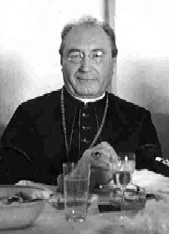 Thus the appointment of the Viennese canon, Dr. Franz Hlawati (28), as Deputy of the Administrator Piffl was noted with a certain relief by the Burgenland regional government (29) as well as by the Ministry of Education. This decision had a good effect. Even though the extremely correct and thoroughly just personality of the Provikar could hardly be particularly sympathetic, he was respected and respected everywhere. On September 24, 1922, the Cardinal, after having sent the Raabian bishop a copy of the appointment decree at his request, officially took over the new Federal State as Apostolic Administrator and, on a journey from Frauenkirchen in the north to Jennersdorf in the south, September to 9 October 1922, presented himself and his Provikar before the Burgenland people and clergy (30). The reception with the faithful was a very friendly one, and the clergy soon gained a good relationship with the new superior, for the Cardinal did not violate the national sentiments of the clergy, but left the clergy time for the spiritual change. Thus began with the year 1922, a new important section in the ecclesiastical history of Burgenland. Endnotes: (1) Since March 15, 1919, Chancellor Dr. Renner was head of the Austrian government, which also led the State Secretariat for Interior and Instruction. On May 9th, Matthias Eldersch took over this State Secretariat. Wilhelm Miklas (10 Years of Reconstruction, Vienna, 1928, p. 35), the later, long-time Federal President of Austria, who had a definite influence on the drafting of this document, was the Under-Secretary-General of the Department of Cultures. In part, these proposals were also taken into account, which had been worked out by the so-called Administrative Office for the Anschluß of German-West Hungary to Austria at its meeting of 4 September 1919. (See the Anschluß archive in the Landesarchiv of Eisenstadt, meeting report.) (2) According to the statistics of 1923, 242,369 (84.9%) of the 285,609 inhabitants of the then Burgenland were Catholic. It is true that the population of the area that originally came to Austria was considerably higher (340,917). Since the percentage of evangelical Christians was actually considerably higher in Ödenburg and the surrounding area, the relationship (by popular vote) shifted somewhat in favor of the non-Catholics. According to an unofficial compilation from 1922, 18.66% of Burgenland's population was non-Catholic. (Diocese Archives, Eisenstadt). (3) According to the document in the Diocesan Archives. (4) These figures should, of course, be taken with caution. Apparently, these are estimates. (5) This attitude is to be understood from the strongly pedagogical education of the Hungarian clergy. In Hungary it was not possible to promote popular consciousness (in addition to the Hungarians, Germans, Croats, Romanians, Slovaks, among others, within the borders of Hungary), but only the idea of the State, which in the Hungarian King's Crown of St. Stephan found a symbolic expression. It was all the more difficult for the Hungarians, when after the World War, the nation was established and the Magyars remained almost alone in the Hungarian State. However, it should not be forgotten that, according to the Hungarian peace treaties, approximately 3.5 million Hungarians had to live in Romania, Yugoslavia, CSR, etc. (6) When this "prior expositio" took place and what wording it had is unknown. (7) In addition to this, possessions in Kroisbach, Weiden am See, etc. are to be expected. (8) They had, however, before the popular vote in Ödenburg, taken the decision to abandon their religious training and to retire to Hungary. The "Schotten" in Vienna, which were to take over the Ödenburger Gymnasium, were selected as successors. (9) This was actually done, but only in 1933, after Cardinal Innitzer, who had been the head of this college before his bishop's consecration, had become the Apostolic Administrator of the Burgenland. (10) His Excellency Dr. Läszlo had inquired about this in the Federal Chancellery and received this communication. (11) Christian Ödenburger Tagblatt, 10 April 1920. (12) Handwritten memorandum on the meeting of 29 July 1921, in the follow-up archive of the Burgenland regional archives, Eisenstadt. (13) ibid. (14) Born on 27th December 1870 in Jennersdorf, ordained on 15 July 1893 in Steinamanger, 1893-1896 Kaplan in Königsdorf, 1896-1905 Administrator and afterwards (until his death) pastor in St. Michael, since 1908 Dechant of the Deputy Stegersbach, was also a Deputy in Budapest, but on 7 November 1920 from the Hungarian government, together with the other Deputies of West-Hungary. His appointment to the Episcopal Vicar took place on October 10, 1921. Thomas died on 20 September 1923. (15) Circulares Sabar., October 10, 1921. (16) Ibid. (17) There was 1 number of a separate official sheet. Also own stamps (imprint on Hungarian brands) came out, which however were officially not recognized by Hungary. (18) The extent to which the decision of the General Vicar in the Styrian region to accompany the Hungarian cavalry had to be examined more closely. He was even accused of treason on the Hungarian side. (19) There is no talk of the Croatian language! (20) Since October 1, 1895, there have been state registers in Hungary. (21) Circulares Sabar., 19 June 1922. (22) Ibid. (23) Original in the Diocesan Archive in Eisenstadt, May 8, 1922. (24) Bishop Mikes, however, was in fact very little in agreement with the Cardinal. It is known, for example, that Mikes visited Esterházy in Vienna, but did not speak to the Cardinal who was waiting for him. (25) Meanwhile, by a decree of 18 May 1922, which was signed by the then Viennese nuncio Franziskus Marchetti Selvaggiani, was officially appointed Apostolic Administrator of Burgenland. (Ecclesiastical stand of A. A. Bgld, 1953, p. 16). (26) This was Dechant Johann Fenneß of Markt St. Martin. (27) For example, the National Council Prelate, Joh. Thullner, with whom Cardinal Piffl very well understood, and also pastor Josef Bauer of Horitschon, Kaplan Ladislaus Stehlik. (28) Born in Bernhardstal in 1868, ordained on July 23, 1893, Provikar from 1922-1932, died July 26, 1940. (29) Original letter from the Governor, September 20, 1922, in the Diocesan Archives. (30) Läszlo, The Incarnation and Growth of the Apostolic Administrator Bgld., Est. Arch. F. Kirchenrecht, 1950, p. 195 ff. |
4) ELLIS ISLAND AND THE CENTRAL RAILROAD TERMINAL While going through the newsletters of ten years ago to choose something for the "Historical BB Newsletter Articles" section (below), I found the following paragraph in a much larger article ["Fun with Feri Tschank", BB News #168B, Article 1, 31 Oct 2007] that was written by Margaret Kaiser: Margaret wrote: Nowadays, when traveling to Ellis Island via the New Jersey harbor side of the Hudson River, visitors first encounter the Central Railroad Terminal, which opened in 1889 and is in process of being restored. This landmark makes a fine adjunct to the Ellis Island immigrant experience since this is the railroad terminal where many of our ancestors boarded trains for in-land destinations. The brick, turreted, 3-level, balconied terminal has a large, impressive waiting room with visitor information, ferry ticketing and other facilities. The many-tracked area to the rear of the terminal is still posted with the route signs from those long-ago days. The terminal now is surrounded by Liberty State Park, a yacht club and modern Jersey City buildings. The Art Deco ferry building on Ellis Island was restored this year, and plans are underway to restore other original buildings as they were during the 1892-1954 years, when Ellis was an immigrant processing station. That paragraph got me thinking about the portion of immigrant travel that gets too little mention in the historical accounts of the great emigrant saga: how did the emigrants get from their initial US port to their final destination? For some of my emigrant ancestors (who all came together in central Minnesota), I have a reasonably solid record of how they traveled. For example, my mother's paternal great-grandfather, Hermann Schaefer, and his family emigrated to America in 1856 from Hegensdorf, Germany, traveling from Bremen aboard the ship "New Orleans." They departed Bremen on 6 Mar 1856 and arrived in New Orleans, LA, on 29 Apr 1856, with stated destination St. Louis. However, they traveled on up the Mississippi river with two other families from Hegensdorf: one family joining relatives in Iowa, the other traveling on with my ancestors and settling quite near each other in central Minnesota, though the exact date of arrival in Minnesota is unknown. My further research revealed that there was regular steamship travel up the Mississippi then that had its most-northerly port at St. Cloud, MN, just 30 miles east of where they settled. On my paternal side, I know exactly when my Steichens arrived in Minnesota, as I have a local newspaper clipping that begins: "June 8, 1865 -- A German named John Steichner, just arrived from the old country...", however, I have found no evidence whatsoever of how they traveled there nor how long it took! For a few other emigrant ancestors, I have ship manifests that document their arrival at east coast ports. For others, nothing at all—they just magically appear in Minnesota! My Burgenländer ancestors fit in that final group... they suddenly appear in some Minnesota records and, while I can limit their travel period to a few years (1888-1889, based on births of children and their claimed emigration years), I know no more. For those of you with ancestors who settled in port cities, their US "travel" seems self-evident. For those of us with Midwest-bound ancestors, many of us wonder how they moved from port to final destination. But it is clear that the Central Railroad of New Jersey Terminal featured in the subsequent travel of many who landed at Ellis Island. 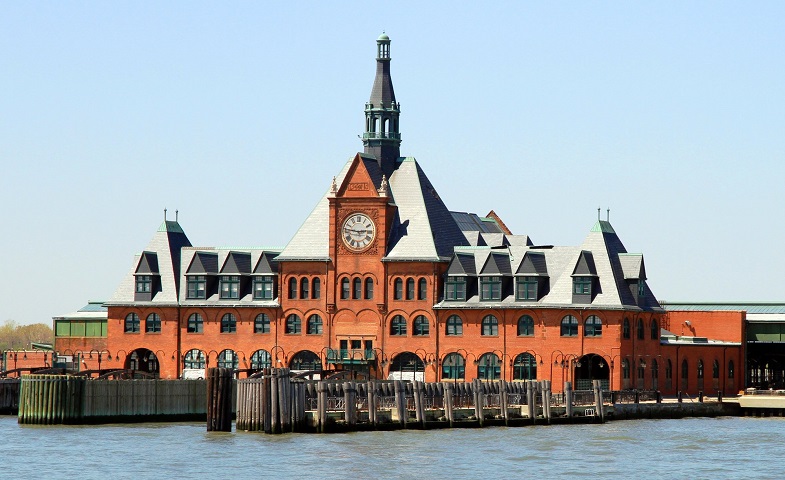 The Central Railroad of New Jersey Terminal I'll tell you more about the Terminal before I speak about the travel experience for emigrants. The Central Railroad of New Jersey Terminal, also known as Communipaw Terminal and Jersey City Terminal, was the Central Railroad of New Jersey's waterfront passenger terminal in Jersey City, New Jersey. The current terminal was built in 1889, replacing an earlier one built in 1864. The Terminal operated until 1967 and was later added to the New Jersey Register of Historic Places and incorporated into Liberty State Park. The terminal was one of five passenger railroad terminals that lined the nearby Hudson River waterfront during the 19th and 20th centuries. However, I'll note that the Central Terminal was the closest to Ellis Island. Of the approximately 17 million people who passed through Ellis Island, nearly two-thirds (10.5 million) are believed to have started their new lives in America by departing on trains from Central Terminal, bypassing New York City to make their way into the United States by way of New Jersey. 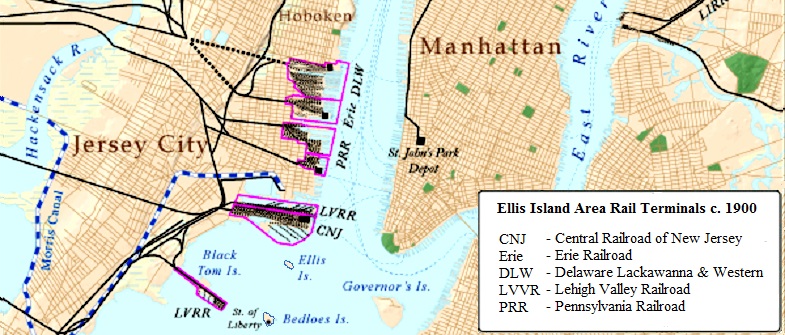 The area where Central Terminal is located has long been known as Communipaw, which in the Algonquian language means big landing place at the side of a river. The first stop west of the station was, indeed, called Communipaw, and was not far from the village that had been established there in 1634 as part of the New Netherland settlement of Pavonia. Central Terminal was built along an empty, open stretch of waterfront known as Communipaw Cove, which was the site of the first ferry service (1661) from the west side of the Hudson River to Manhattan. The marshy cove was once known for its oyster beds, fishing and marsh grass, but, in 1860, the state of New Jersey granted the Central Railroad access to the area to begin construction of a small yard and passenger terminal. Originally opened in 1864, the station proved inadequate by the 1880s, so the Central Railroad expanded the entire complex. To do so required more fill to be brought in to build up the waterfront for the larger terminal. The railroad also expanded the already massive yard complex, to more than 1.5 miles from its mainline connection to the west, and included a roundhouse, marine repair yard, steamship piers and freight piers. This new yard was used for both passenger (mostly commuter) and freight trains and, eventual, for special immigrant trains for passengers arriving at nearby Ellis Island. The main building is designed in a Richardsonian Romanesque style and was Central Railroad’s most famous railroad station, as it stood over three stories tall with a beautiful centered bell tower. As an intermodal facility (a facility that connects different modes of travel), it contained more than a dozen railroad platforms, several ferry slips, and a bus station. Arriving ferry passengers would walk to the railhead concourse and could either pass through its main waiting room, by-pass it on either side or take stairs to the upper level. The ferry slips have been restored, though the structure which housed them has been removed, as have the tracks. The train sheds, the largest ever, were not part of the original construction, but were built in 1914, at which time a double-deck ferry shed and more ferry slips were added. While Central Railroad used the complex for its own trains, allied railroads like the Reading and Baltimore & Ohio also used the facility. Despite the size and elegance of the Terminal, Central Railroad of New Jersey was not a prominent railroad, never reaching more than a few hundred miles in length at its largest. The Terminal played host to many commuter trains and serviced Ellis Island but saw few of the then well-known "named" passenger trains. Today, save for the terminal and its train shed, little evidence remains of the once sprawling railroad operations. From the Terminal, visitors can take ferries to the Statue of Liberty and the Ellis Island Immigration Station, or tour Liberty State Park, New Jersey's largest urban state park. During Superstorm Sandy (2012), the Terminal experienced serious structural damage. It was closed until renovations eventually costing approximately $20 million could be completed. In the renovation, the mechanical and the electrical equipment were elevated as a precautionary measure. After repairs to windows, doors, roofing and cupola were completed, the building was reopened in 2016. So, with the opening of the elegant Central Terminal in 1889, at the time of heaviest immigration to the United States from Europe, one would think our ancestors felt welcomed during their initial steps into the country...  but
that really wasn't the case... even at Ellis Island. As you know, immigrants had to go
through a number of inspections at Ellis Island. When those inspections were complete,
the immigrant was directed to a three-way divided staircase that came to be known as the
Stairs of Separation. To the left, the door at the bottom led to the ferry going to New York
City, where further connections to New England could be made. To the right, the door for western
and southern destinations led to the railroad ticket office for the New Jersey terminals. Down
the center, was the door to the detention center and possible deportation back to the land from
which they came. but
that really wasn't the case... even at Ellis Island. As you know, immigrants had to go
through a number of inspections at Ellis Island. When those inspections were complete,
the immigrant was directed to a three-way divided staircase that came to be known as the
Stairs of Separation. To the left, the door at the bottom led to the ferry going to New York
City, where further connections to New England could be made. To the right, the door for western
and southern destinations led to the railroad ticket office for the New Jersey terminals. Down
the center, was the door to the detention center and possible deportation back to the land from
which they came.One could easily argue that directing those immigrants headed to western or southern destinations directly to the railroad ticket office was for their own convenience and safety, as it protected immigrants from swindlers in the big city, but it also allowed the government to ensure that the immigrants were on their way to a specific destination with money in hand, that they would not become public charges, and that they would not offend New Yorkers, with their American prejudices against newly-arrived foreigners, by unnecessarily mixing with them. Singer/composer Tom Russell captured this reality in a song titled Mary Clare Malloy (on his family genealogy song-cycle album, The Man From God Knows Where, that I mentioned last month). He wrote these words for his ancestor Mary, who sailed from Ireland "with seven hundred picture brides": 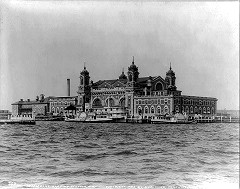 My first taste of the New World turned to ashes very fast
My first taste of the New World turned to ashes very fastThe ones who entered freely were from first and second class We steerage folk remained on board, as if we were exiles The captain turned the ship around and sailed toward Ellis Isle My best friend was deported back, to a poor Killea
home
|
5) HISTORICAL BB NEWSLETTER ARTICLES Editor: This is part of our series designed to recycle interesting articles from the BB Newsletters of 10 years ago. Below is part of a longer article, being selections from a section written by Fritz Königshofer. Fritz writes about the ethnicities in pre-1921 Vas county and the sectioning of that county as part of the break-up of the Austro-Hungarian Monarchy after WW-I. THE BURGENLAND BUNCH NEWS - No. 168A October 31, 2007 FOLLOW-UP TO BB NEWSLETTER #167 - FAMILY SOLAR (SZOLLER) Fritz Königshofer wrote (in part): This evening I noted the article about the search for the home town of your great grandfather, Francis X. Solar. Klaus Gerger pointed you to the town Dolnji Slaveci in the Republic of Slovenia, which pre-WW-I was called Alsócsalogány, located in the Muraszombat district of Vas county, Hungary. Ferencz (Frank) [Solar] stated his ethnicity as German [on his emigrant ship manifest]. According to the data of the 1910 census, nearly all 800 inhabitants of Alsócsalogány declared their ethnicity as "Wend" (Slovenian); only 30 listed German. It is quite possible that Frank had lived and worked in Szentgotthárd and still stated Alsócsalogány as his last residence. He probably grew up in Alsócsalogány and had home rights (predating the concept of citizenship) there. The fine distinctions between last residence and place of origin were not always precisely reflected in the earlier ship manifests. The German ethnicity of Frank and his wife are not overly surprising. The old (pre-WW-I) county of Vas was ethnically very mixed. According to the census of 1910, a bit more than 50% declared themselves as Magyars (Hungarians), more than a quarter as Germans, and more than 10% as Vends (Slovenians). There were also less than 5% Croats. Most of the ethnic Germans lived in the western part of the county. As a result of the break-up of the Austro-Hungarian Monarchy after WW-I, the western part of Vas was severed from Hungary and became the southern part of the new Austrian state of Burgenland. The southern part of old Vas county was severed too, and became part of the new country Yugoslavia. After its breakup in the early 1990s, it is now the Republic of Slovenia. [Editor: The map below shows the Ethnic Makeup of Vas County per the data from the 1910 census. Each village is marked by colored squares representing its ethnicity, where red = Hungarian; pink = German; light blue = Croatian; and light violet = Slovene (these violet markers tend to blend with the grey map so you need to look closely for them). I have added a solid red line to indicate the territory that became Burgenland (i.e., the upper left section) and a solid green line for territory that went to Yugoslavia/Slovenia (bottom left). In addition, I have added yellow lines to marked the pre-1921 districts (járás).] 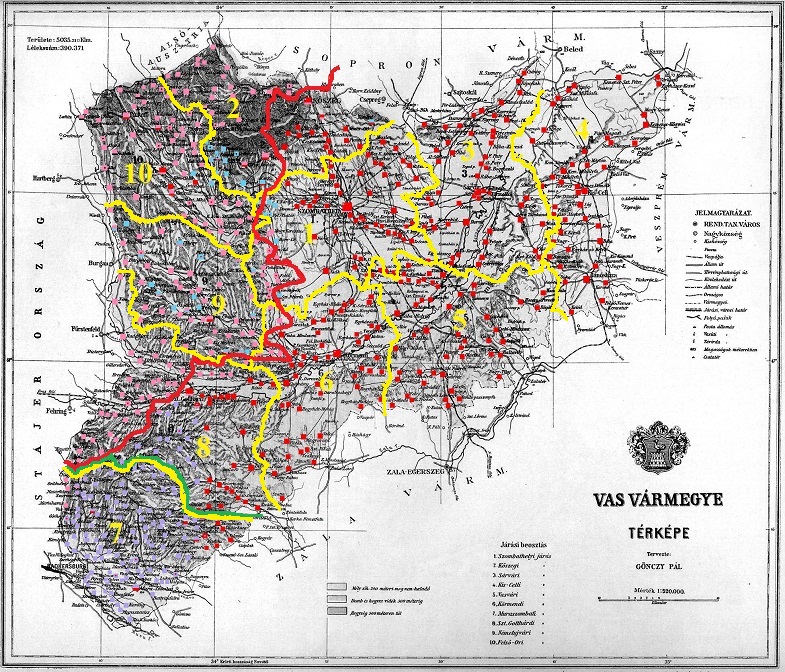 Old Vas County: Map of Ethnicities, Districts and 1921 Divisions [based on: Zello, CC BY-SA 4.0, commons.wikimedia.org/w/index.php?curid=43246235] In old Vas county, most of the ethnic Slovenians lived in the district of Muraszombat, the most southern district of old Vas county. Some ethnic Slovenians lived in the southern parts of the district of Szentgotthárd. Many of the "Slovenian" towns had traditional Slovenian names (though slightly Magyarized). In the early 20th century, Hungary embarked on a project to assign unique place names to all Hungarian towns and villages and, in the process, replace all [non-"Hungarian"] place names by new names. The name Alsócsalogány is likely among the names only created in the early 20th century. These "last-minute" name changes make record searching a bit more difficult than usual. [Editor: All of Muraszombat járás, marked 7 in the map above, went to Yugoslavia. Szt. Gotthárdi járás (8) was split between Burgenland and Hungary, as was Köszegi járás (2). Németujvári járás (9) and Felsö-Ori járás (10) were almost, but not quite, completely transferred to Burgenland. Small parts of Körmendi járás (6) and Szombathelyi járás (1) were also transferred to Burgenland. Overall, this was a fairly accurate division of territory based on ethnicity. If you examine the map closely, you will see that there were a few German (pink) villages that remained in Muraszombat járás (just below the end of the Burgenland territory) and a sprinkle of Hungarian villages (red) on the other side of the járás. The only other region where German (pink) villages remained in Hungarian territory (other than by later re-transfer) was in the northern part of Szt. Gotthárdi járás (8). However, a fair number of Slovenian villages (light violet) remained in Szt. Gotthárdi járás near the land transferred to Burgenland. Almost all Croatian villages (light blue) transferred into Burgenland except a small group in Szombathelyi járás (1). If you would like to examine this map in more detail, a higher resolution image is available here, however the district lines appear only in black]. The traditional name of Alsócsalogány was Alsó-Slavecza. In the Dvorzsák book of Hungarian place names of 1870, you will find your ancestral town under the latter name in the district of Muraszombat. To see the Dvorzsák listings, link to: http://kt.lib.pte.hu/cgi-bin/kt.cgi?konyvtar/kt03110501/tartalom.html. The Dvorzsák entry shows the place of the Roman Catholic parish (and records) as Tót Szent György (403 souls in Alsó-Slavecza), the Lutheran parish as Bodoncz (231 souls), and the Jewish congregation at Muraszombat (9 souls). In the subsequent reform of place names, Tót Szent György became Vizlendva, while Bodoncz became Bodóhegy. When a couple already lived in the USA, it is quite likely that they sent information back to the old country about the births of their children. This was likely a requirement (though not always obeyed). You would find the information in the civil records. As for Alsócsalogány, civil recording may well have been in Vizlendva, or alternatively in nearby Felsölendva. |
6) ETHNIC EVENTS LEHIGH VALLEY, PA Friday-Sunday, October 6-8, 13-15: Oktoberfest at Steel Stacks in Bethlehem. Info: www.steelstacks.org Saturday, October 21: Weinlesefest at the Lancaster Liederkranz. Music by Maria & Heimatecho. Info: www.lancasterliederkranz.com NEW BRITAIN, CT Friday, October 6, 7 pm: Heimat Abend. Austrian Donau Club, 545 Arch Street, $3. Music by Joe Rogers and his band. Friday, October 20, 7:30 pm: Heurigan Abend. Austrian Donau Club, 545 Arch Street, $3. Music by Schachtelgebirger Musikanten. |
7) BURGENLAND EMIGRANT OBITUARIES Emil Bartolowits  Emil
Bartolowits, age 95, of Ninilchik, Alaska, died at his home surrounded by his children on
Saturday, Aug. 26, 2017. Born on Oct. 20, 1921, in Weichselbaum, Austria to the late John and
Aloisia (Kloiber) Bartolowits, he immigrated to the United States through Ellis Island at the
age of 8. Emil
Bartolowits, age 95, of Ninilchik, Alaska, died at his home surrounded by his children on
Saturday, Aug. 26, 2017. Born on Oct. 20, 1921, in Weichselbaum, Austria to the late John and
Aloisia (Kloiber) Bartolowits, he immigrated to the United States through Ellis Island at the
age of 8.He grew up in Pittsburgh, Pa., where he met the love of his life, Fran, and married her on June 29, 1946. Together they traveled to Clam Gulch, Alaska, and were one of the original homestead families in the Clam Gulch area. Emil enjoyed making beer and wine, fishing, golfing, dancing and playing cards. In later life, he loved processing meats and cooking for the family. A true patriot, Emil served his country, from 1940 to 1946, as a Platoon Sergeant in the Marine Corps. He fought in the South Pacific and was a Purple Heart recipient. Emil was preceded in death by his son, Eric; and his wife, Fran. He is survived by his daughter, Tessa and son-in-law Tony Wilson; son, Paul and daughter-in-law LaRae Bartolowits; son, Rich Bartolowits; grandchildren, Allen Wilson and his wife Stephanie, Michael Wilson and his wife Angela, Jennifer, Ashley and her husband Garrett, Michelle and Matthew Bartolowits; and great-granddaughter, Niki Wilson. Emil's final words were: "Everything is fine." A Celebration of Life Mass, followed by a reception, will be held at 3 p.m. on Saturday, Sept. 9, 2017, at St. Peter the Apostle Catholic Church in Ninilchik, Alaska. In lieu of flowers, donations in Emil's name may be made to Wounded Warriors at supportwwp.org, or Wounded Warrior Project P.O. Box 758517, Topeka, KS 66675; or to the Ninilchik Senior Center, P.O. Box 39422, Ninilchik, AK 99639. Arrangements made by Peninsula Memorial Chapel & Crematory. Please visit or sign his online guestbook at AlaskanFuneral.com. Published in Alaska Dispatch News on Sept. 6, 2017 Andrew Spiegl  Andrew
Spiegl, age 98, died at his home in Encino, California on Friday, September 15, 2017, after a
3-month illness. Andrew
Spiegl, age 98, died at his home in Encino, California on Friday, September 15, 2017, after a
3-month illness.Born on March 5, 1919, in Zurndorf, Austria, Mr. Spiegl apprenticed as a grocer before he and his family fled to Vienna in 1938. He rescued his entire family from the Holocaust by securing them all visas and passage out of Europe. Mr. Spiegl arrived in the United States in 1939, when he was 19 years old, where he met his future wife, Liese Sondermann, a refugee from Germany. He began working in the kitchen of the Biltmore hotel in downtown Los Angeles. He and his wife eventually bought a small grocery store. Mr. Spiegl later went into sales, ultimately opening his own business, Bonus-Built, where he invented, among other things, a space-saving cart that the US Postal Service still uses. Mr. Spiegl tirelessly recruited and fundraised for the City of Hope, raising millions of dollars. About 20 years ago, he developed the City of Hope's Board of Governors. That organization recently made Mr. and Mrs. Spiegl honorary Lifetime Members. He leaves his wife of 74 years, Liese; his sister, Margaret; his daughter, Deborah Spiegl Slosberg; four grandchildren, and numerous nieces and nephews. He was preceded in death by his daughter, Linda, and his sister, Judith. Services will be held at 11 a.m. on Tuesday, September 19, at Eden Memorial Park, 11500 Sepulveda Blvd, Mission Hills, CA 91345. Published in the Los Angeles Times on Sept. 17, 2017 |
| END OF NEWSLETTER (Even good things must end!) |
NOTICE (Informal Terms and Conditions): The Burgenland Bunch (BB) was formed and exists to assist Burgenland descendants in their research into their heritage and, toward that end, reserves the right to use any communication you have with us (email, letter, phone conversation, data upload, etc.) as part of our information exchange and educational research efforts. ● If you do not want your communication to be used for this purpose, indicate that it is "confidential" and we will attempt to abide by that request. ● Correspondents who communicate with the BB without requesting confidentiality retain their copyright but give a non-exclusive license to the BB allowing us to forward to BB members, publish in our monthly newsletter or on our website, and/or subsequently and permanently archive all or parts of such communications. The formal Burgenland Bunch Website Usage Agreement can be found here: Agreement The Burgenland Bunch homepage (website) can be found at: the-burgenland-bunch.org Burgenland Bunch Newsletter, copyright © 2017 by The Burgenland Bunch All rights reserved. Permission to copy excerpts granted if credit is provided. |
 News
News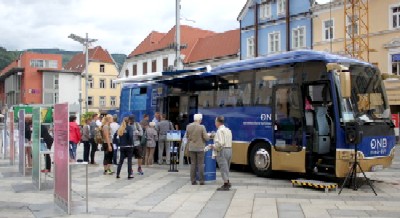 This
past month, the blue Euro-bus moved through Burgenland, with stops in Güssing, Pinkafeld,
Neusiedl am See, and elsewhere. What is different this time is that it is nearly the last
opportunity to exchange two specific Schilling banknotes: the 500 Schilling bill with Otto
Wagner on the front (=36.3€ =$43.17) and the 1000 Schilling bill 72.7€= $86.34) with Erwin
Schrödinger on the front, which can only be changed until 20 April 2018. Those bills will become
permanently invalid after that date. They join five Schilling banknotes issued before 1983 that
have already expired and the 5 and 10 Schilling silver coins that ceased to be legal tender in
1969 and 1975. So, if you hold any of these notes, exchange them soon.
This
past month, the blue Euro-bus moved through Burgenland, with stops in Güssing, Pinkafeld,
Neusiedl am See, and elsewhere. What is different this time is that it is nearly the last
opportunity to exchange two specific Schilling banknotes: the 500 Schilling bill with Otto
Wagner on the front (=36.3€ =$43.17) and the 1000 Schilling bill 72.7€= $86.34) with Erwin
Schrödinger on the front, which can only be changed until 20 April 2018. Those bills will become
permanently invalid after that date. They join five Schilling banknotes issued before 1983 that
have already expired and the 5 and 10 Schilling silver coins that ceased to be legal tender in
1969 and 1975. So, if you hold any of these notes, exchange them soon. The
initial German-language course is taught in cooperation with health care providers and cover the
value and orientation knowledge. Mastery of this material and the associated German vocabulary
is required before graduating to the second course.
The
initial German-language course is taught in cooperation with health care providers and cover the
value and orientation knowledge. Mastery of this material and the associated German vocabulary
is required before graduating to the second course. Update
for book "The Burgenländer Emigration to America": Here is this month's update on
purchases of the English issue of the 3rd edition of Dr. Walter Dujmovits' book "Die
Amerika-Wanderung Der Burgenländer."
Update
for book "The Burgenländer Emigration to America": Here is this month's update on
purchases of the English issue of the 3rd edition of Dr. Walter Dujmovits' book "Die
Amerika-Wanderung Der Burgenländer." NUT-FREE
VANILLA KIPFERL (from Kathy Stallone)
NUT-FREE
VANILLA KIPFERL (from Kathy Stallone) PUMPKIN
SEED KIPFERL (from Gunter Gablerits)
PUMPKIN
SEED KIPFERL (from Gunter Gablerits) Reminder:
We no longer have a "regular" source for Burgenland recipes. As evidenced above, a few readers
have shared favorite family recipes, and we do have a reserve for a couple of months now, but if
contributions stop coming in, we'll be begging again! So, please consider sharing your favorite
Burgenland recipes or recipe books with us. Our older relatives sadly aren't with us forever, so
don't allow your allow your favorite ethnic dishes to become lost to future generations. Send
your suggestions to BB Recipes Editor,
Reminder:
We no longer have a "regular" source for Burgenland recipes. As evidenced above, a few readers
have shared favorite family recipes, and we do have a reserve for a couple of months now, but if
contributions stop coming in, we'll be begging again! So, please consider sharing your favorite
Burgenland recipes or recipe books with us. Our older relatives sadly aren't with us forever, so
don't allow your allow your favorite ethnic dishes to become lost to future generations. Send
your suggestions to BB Recipes Editor,

 Following
their examination, the immigrants were directed into “pens” and grouped alphabetically at the
terminal. Their information was then verified, and they were redirected again. Immigrants
remaining in Baltimore were led to another pen to wait for friends or relatives. Other
immigrants went to the ticket counter and bought their tickets for trains heading west.
Following
their examination, the immigrants were directed into “pens” and grouped alphabetically at the
terminal. Their information was then verified, and they were redirected again. Immigrants
remaining in Baltimore were led to another pen to wait for friends or relatives. Other
immigrants went to the ticket counter and bought their tickets for trains heading west. 